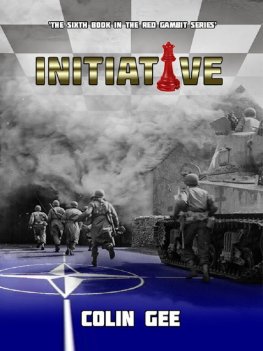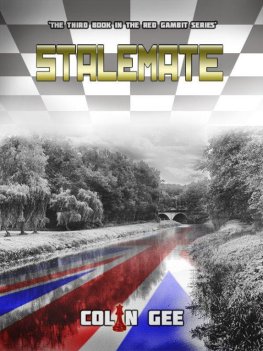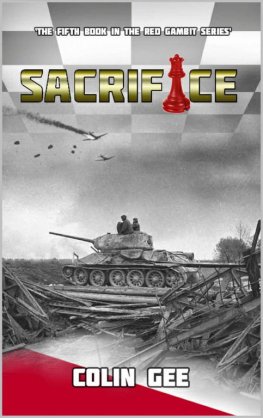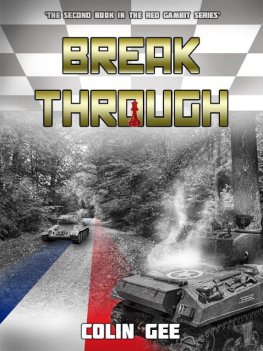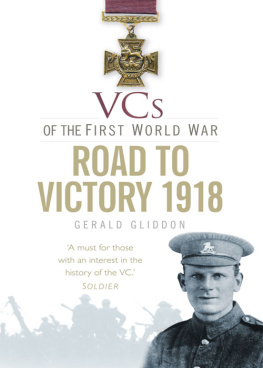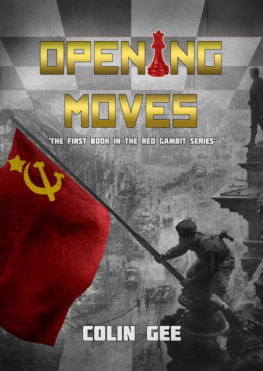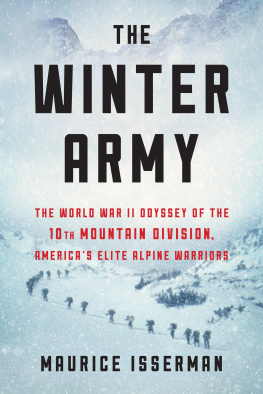INITIATIVE
25th April 1946 to 19th August 1946.

WRITTEN BY COLIN GEE
The Red Gambit series of books is dedicated to my grandfather, the boss-fellah, Jack Chalky White, Chief Petty Officer [Engine Room] RN, my de facto father until his untimely death from cancer in 1983, and a man who, along with many millions of others, participated in the epic of history that we know as World War Two.
Their efforts and sacrifices made it possible for us to read of it, in freedom, today.
Thank you, for everything.
Overview by author Colin Gee
If you have already read the first five books in this series, then what follows will serve as a small reminder of what went before.
If this is your first toe dipped in the waters of Red Gambit, then I can only advise you to read the previous books when you can.
In the interim, this is mainly for you.
After the end of the German War, the leaders of the Soviet Union found sufficient cause to distrust their former Allies, to the point of launching an assault on Western Europe. Those causes and the decision-making behind the full scale attack lie within Opening Moves, as do the battles of the first week, commencing on 6th August 1945.
After that initial week, the Soviets continued to grind away at the Western Allies, trading lives and materiel for ground, whilst reducing the combat efficiency of Allied units from the Baltic to the Alps.
In Breakthrough, the Red Army inflicts defeat after defeat upon their enemy, but at growing cost to themselves.
The attrition is awful.
Matters come to a head in Stalemate as circumstances force Marshall Zhukov to focus attacks on specific zones. The resulting battles bring death and horror on an unprecedented scale, neither Army coming away unscathed or unscarred.
In the Pacific, the Soviet Union has courted the Empire of Japan, and has provided unusual support in its struggle against the Chinese. That support has faded and, despite small scale Soviet intervention, the writing is on the wall.
Impasse brought a swing, perhaps imperceptible at first, with the initiative lost by the Red Army, but difficult to pick up for the Allies.
The Red Air Force is almost spent, and Allied air power starts to make its superiority felt across the spectrum of operations.
The war takes on a bestial nature, as both sides visit excesses on each other.
Allied planning deals a deadly blow to the Soviet Baltic forces, in the air, on the sea, and on the ground. However, their own ground assaults are met with stiff resistance, and peter out as General Winter spreads his frosty fingers across the continent, bringing with him the coldest weather in living memory.
Sacrifice sees the Allied nations embark on their recovery, assaults pushing back the weakening red Army, for whom supply has become the pivotal issue.
Its soldiers are undernourished, its tanks lack enough fuel, and its guns are often without shells.
Soviet air power is a matter of memory, and the Allies have mastery of the skies.
In the five previous books, the reader has journeyed from June 1945, all the way to April 1946. The combat and intrigue has focussed in Europe, but men have also died in the Pacific, over and under the cold waters of the Atlantic, and on the shores of small islands in Greenland.
Battles have occurred from the Baltic to the Adriatic, some large, some small, some insignificant, and some of huge import.
In Initiative, the fighting develops again, and the book deals with that, as well as the other matters of war, that will take the reader from the Kalahari Desert to an airfield on Tinian, from China to the Black Sea coast, and from a Swedish castle to a hotel in Bretton Woods, New Hampshire.
As I did the research for this alternate history series, I often wondered why it was that we, west and east, did not come to blows once more.
We must all give thanks it did not all go badly wrong in that hot summer of 1945, and that the events described in the Red Gambit series did not come to pass.

My profound thanks to all those who have contributed in whatever way to this project, as every little piece of help brought me closer to my goal.

[For additional information, progress reports, orders of battle, discussion, freebies, and interaction with the author please find time to visit and register at one of the following-
www.redgambitseries.com, www.redgambitseries.co.uk, www.redgambitseries.eu,Also, feel free to join Facebook Group Red Gambit.]Thank you.
I have received a great deal of assistance in researching, translating, advice, and support during the years that this project has so far run.
In no particular order, I would like to record my thanks to all of the following for their contributions. Gary Wild, Jan Wild, Jason Litchfield, Peter Kellie, Jim Crail, Craig Dressman, Mario Wildenauer, Loren Weaver, Pat Walsh, Keith Lange, Philippe Vanhauwermeiren, Elena Schuster, Stilla Fendt, Luitpold Krieger, Mark Lambert, Simon Haines, Carl Jones, Greg Winton, Greg Percival, Robert Prideaux, Tyler Weaver, Giselle Janiszewski, James Hanebury, Renata Loveridge, Jeffrey Durnford, Brian Proctor, Steve Bailey, Paul Dryden, Steve Riordan, Bruce Towers, Gary Banner, Victoria Coling, Alexandra Coling, Heather Coling, Isabel Pierce Ward, Hany Hamouda, Ahmed Al-Obeidi, Sharon Shmueli, and finally BW-UK Gaming Clan.
It is with sadness that I must record the passing of Luitpold Krieger, who succumbed to cancer after a hard fight.
One name is missing on the request of the party involved, who perversely has given me more help and guidance in this project than most, but whose desire to remain in the background on all things means I have to observe his wish not to name him.
None the less, to you, my oldest friend, thank you.
Wikipedia is a wonderful thing and I have used it as my first port of call for much of the research for the series. Use it and support it.
My thanks to the US Army Center of Military History and Franklin D Roosevelt Presidential Library websites for providing the out of copyright images.
All map work is original, save for the Chteau outline, which derives from a public domain handout.
Particular thanks go to Steen Ammentorp, who is responsible for the wonderful www.generals.dk site, which is a superb place to visit in search of details on generals of all nations. The site has proven invaluable in compiling many of the biographies dealing with the senior officers found in these books.
If I have missed anyone or any agency I apologise and promise to rectify the omission at the earliest opportunity.

At one stage in the writing of Initiative, I found myself at a real crunch point, where I wondered about one part of my overall story, and fortunately had the sense to put it to a group of American members of the Facebook group. I am extremely grateful that I did so, as it was quickly established that a crucial piece of my US story simply wouldnt stand up to close examination by an American audience.
I am very indebted to the following members of the Facebook group for coming to my aid.
Thanks go to Giselle Janezewski, James Hanebury, Gary Banner, Keith Lange, Bruce Towers, Jim Crail, and Robert Clarke.
The correlation between the Allied and Soviet forces is difficult to assess for a number of reasons.
Neither side could claim that their units were all at full strength, and information on the relevant strengths over the period this book is set in is limited as far as the Allies are concerned and relatively non-existent for the Soviet forces.

